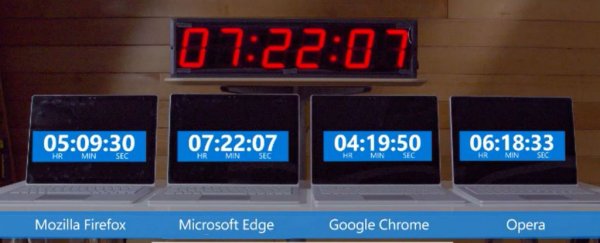If you feel like your laptop might as well be a PC because of how entirely codependent it is with its power cord, don't worry, we get it. The struggle is real.
But as we wait for wireless charging to actually become a thing (please be a thing), we have to make do with what we have, and it looks like shutting Chrome down and firing up something more economical is the first thing you should be doing at times of need.
As you can see in the demonstration from Microsoft below, when identical laptops were left to run four different browsers - Mozilla Firefox, Chrome, Opera, and Microsoft Edge - in a lab-controlled environment, Chrome absolutely hammers that battery.
In this experiment, which had the four laptops run typical browsing behaviour on a number of popular websites until the battery ran dry, the Chrome computer lasted just 4 hours and 19 minutes, the Firefox computer lasted 5 hours and 9 minutes, and the Opera battery-saving mode computer tapped out at 6 hours and 18 minutes.

The Microsoft Edge computer let its hypothetical user last an impressive 7 hours and 22 minutes before they had to curse at the screen, throw the cat off their lap, and haul their first-world-problems butt up the stairs to find the cord.
Comparing Edge to Chrome, that's a 70 percent increase in time spent unplugged, and at more than 7 hours of battery life, that's entire average work day. So bravo, Microsoft, that's actually pretty cool.
To explain the differences, Microsoft also looked at the power consumption of the four computers' Wi-Fi, CPU, and GPU during the experiments, as each browser cycled through common sites including Facebook, YouTube, Wikipedia, and Amazon. Typical browser behaviour involved opening websites, scrolling through articles, watching HD videos, and opening new tabs for each task.
As you can see in the graph below, the collective telemetry - an automatic measurement of wireless data transmission - from millions of users found that Edge uses up 465 mW, while Chrome needs more than 719 mW. They recorded 493 mW for Firefox.
"[W]e measure aggregated telemetry from millions of Windows 10 devices around the world. The billions of data points from these devices are consistent with the lab results, demonstrating that Microsoft Edge is more efficient in real-world, day-to-day use than the competition," Microsoft writes on its blog.
 Microsoft
Microsoft
Of course, this is all just one giant ad from Microsoft to get you using Edge instead of Chrome, Firefox, or Opera, and what they're not telling you is that Chrome can do a lot of things that Edge can't, such as allowing for browser extensions.
Microsoft says it's working on improving Edge's efficiency and versatility in time for the Windows 10 Anniversary update, and Peter Bright explains the details over at Ars Technica:
"Flash content that is not deemed to be central to a page's content will become click-to-play, which is something that other browsers also do. Background tabs will also use fewer resources by making their JavaScript timers fire less frequently and by using coalescing to ensure that they all fire together and hence reduce the number of times that the processor must be woken up.
This shouldn't interfere with listening to music or, say, checking for mail in a background tab, but it should reduce the overhead due to spurious animations and so on."
But hey, don't let Microsoft tell you what to do. If you like Chrome, keep using Chrome… until you're on your last 10 percent and really don't want to get up and find the power cord. And that 70 percent extra battery life could definitely come in handy on long flights.
There's no way of knowing at this stage if the improved Edge will keep up its power savings, but as Bright points out, it might actually be a really good option for mobile right now.
If you switch over to Edge when you need the extra juice, and follow some of these tips, maybe you won't feel like such a cord slave anymore.
